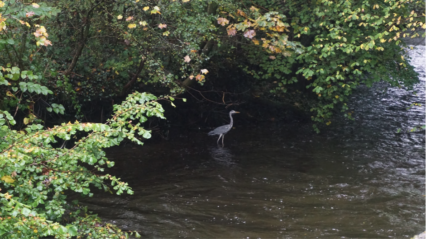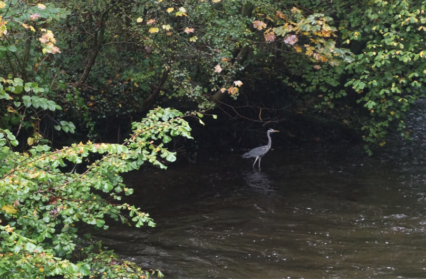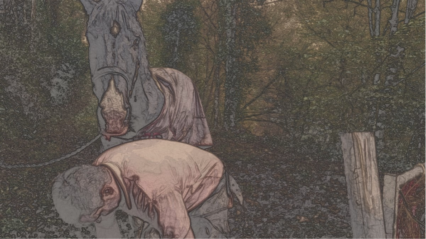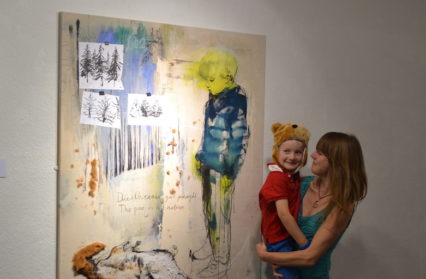Something Else is Going On in the River is a contribution by clare e. potter, as part of her residency at Wales Arts Review. Throughout 2017 these artists, including clare e. potter will take a leading creative role in what Wales Arts Review publishes, centring their skills on a challenging project over the course of a month. We were inundated with applications, receiving hundreds of emails about the positions, and it was no easy task whittling down all that talent to this final eleven. Our team of six editors debated long into the night, and in the end, we decided on a collection of people who we most want to work with, and whose work excites us. We think you will be excited by them too.
Something else is going on with the river
More vital than death
-Ted Hughes ‘Salmon Eggs’

Something else is going on with the river more vital than the death of our dog a quarter of a century ago, consumed by its swell. Something else is going on with the river more vital than the death of that little boy whose body they never found. Something else is going on with the river more vital than the death of our coal mines, the death of our forefathers whose picks and shovels laboured in deep parallel to this artery . . .
Hughes was right, it’s with the river. Not in the river: I won’t find a poem or a story or a moment of peace, enlightenment, puzzlement in the river. Better to be with the river whose force has a voice which makes itself known through the people who walk it, fish it, run along with it, sit and recite a poem by it, or lob a stone for the thlunk—to know the underbelly.
To know the river is to know its people.
For a while, I couldn’t settle on an idea for this residency. I’d started dreaming of the Mississippi again. For years, I’d lived two blocks from that immense body of water. Plenty still to talk about there, though I didn’t want to go back to jazz and foghorns and flood and loss.
But that’s the way it is, that mighty river was trying to get my attention (again), this time-I’ve translated-calling me to connect to my childhood rivers: the Rhymney, the Sirhowy and all their tributaries, fingers that wrapped around Cefn Fforest village-like hands in prayer.
And what made me certain that there was something to be gained in immersing myself in the subject of these rivers was this:
Two weeks ago, driving around the hairpin bend at Viaduct Lane which snakes together Hengoed and Maesycwmmer, I saw a young girl paused with her horse and a farrier beside the Rhymney river. Apart from the van with the farrier’s name decaled on it, this could have been a scene from a Thomas Hardy novel. Sounds of the shoe on the anvil, the hammering ricocheting off the viaduct pillars echoing upriver, the smell of burnt hoof, the dull knock of nails, and the farrier with his leather apron, face sweating with immense effort. The horse, an Irish Sport horse, despite her raging toothache and swollen abscess, relaxed her leg into the fold of his body, gave her foot gently. And he filed and clipped and filed rhythmically, unafraid—unlike me, cautious of the power restrained in the flanks of that quiet animal.
At this point, I realised it wasn’t necessarily the rivers that should be my focus of exploration, but the people who happen along with them. This incredibly beautiful moment that felt outside of this modern era was an invitation. Perhaps these three were ghosts, perhaps I’d turned the bend in the road too sharply and arrived at another place, the place before. It showed me there is something else going on with the river, not of this time but of other times that like echoes travel far from their source while baring traces of it; that is moving along the banks, I might be able to know them, and in turn better know myself, where I grew up and what impact it had to be nurtured between two rivers.
I’ve already interviewed four people. One generous man spoke for an hour and a half; what he shared was a treasure. I’m having difficulty getting the audio software to best depict the voices, the something else about the river that comes not just from these people’s stories, but the pauses between the words that evoke affection for this stretch of river or that stretch of river, as if it was his or her own. And it is, I’m finding.
I hadn’t expected to struggle so much with the technology of clipping audio, having to do real deep-listening. I hadn’t expected people to bear such emotion when recounting stories of how their lives are connected to the Rhymney, the Sirhowy. These rivers are like the lines on our palms, unique and deep for each of us, traversing our own bends, divining our future as told by our past.
So that’s what I’ll be doing (if I can get myself through the process of how to edit audio). I’ll be sharing the voices of those who feel the rivers’ vitality, and by extension, their own.













